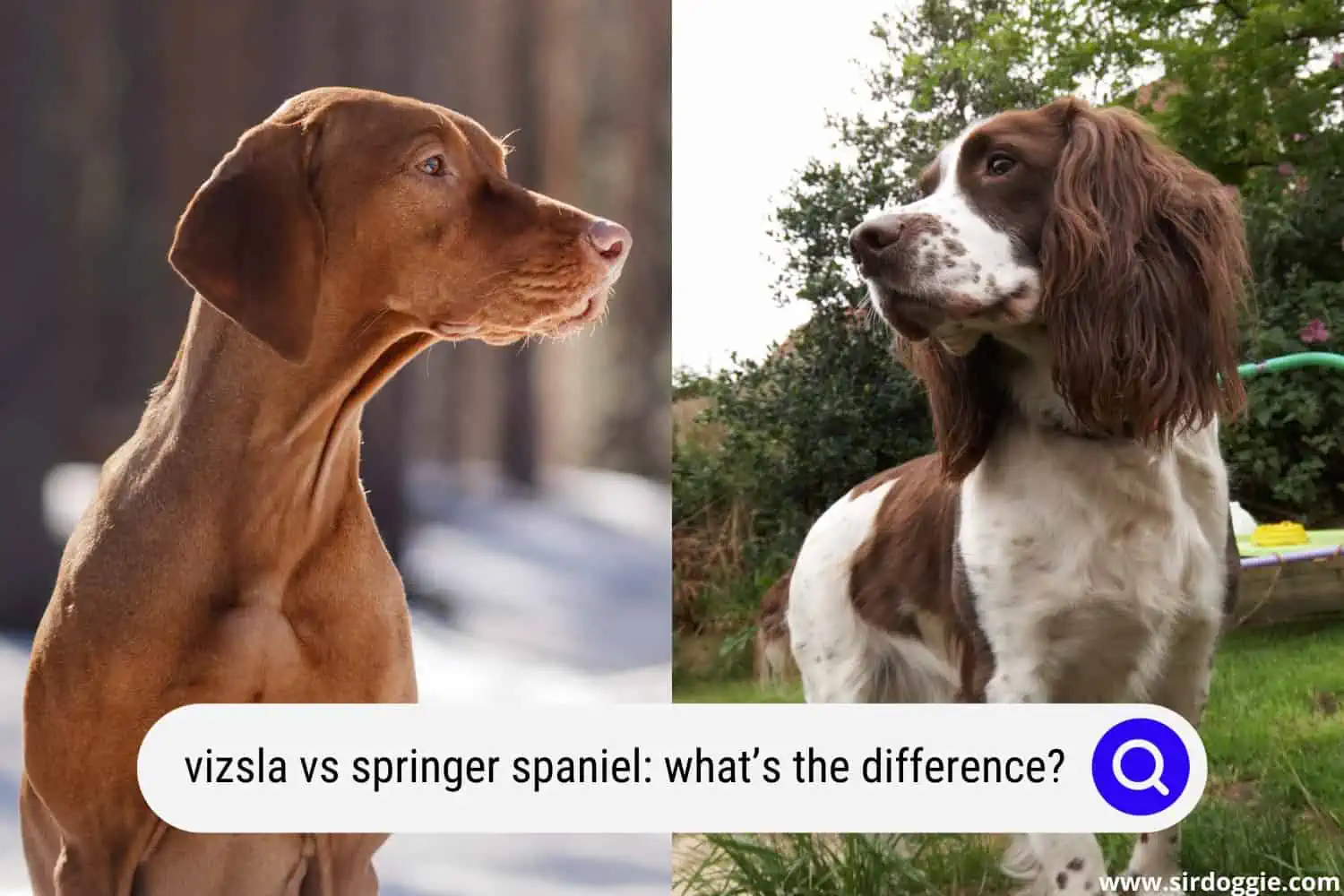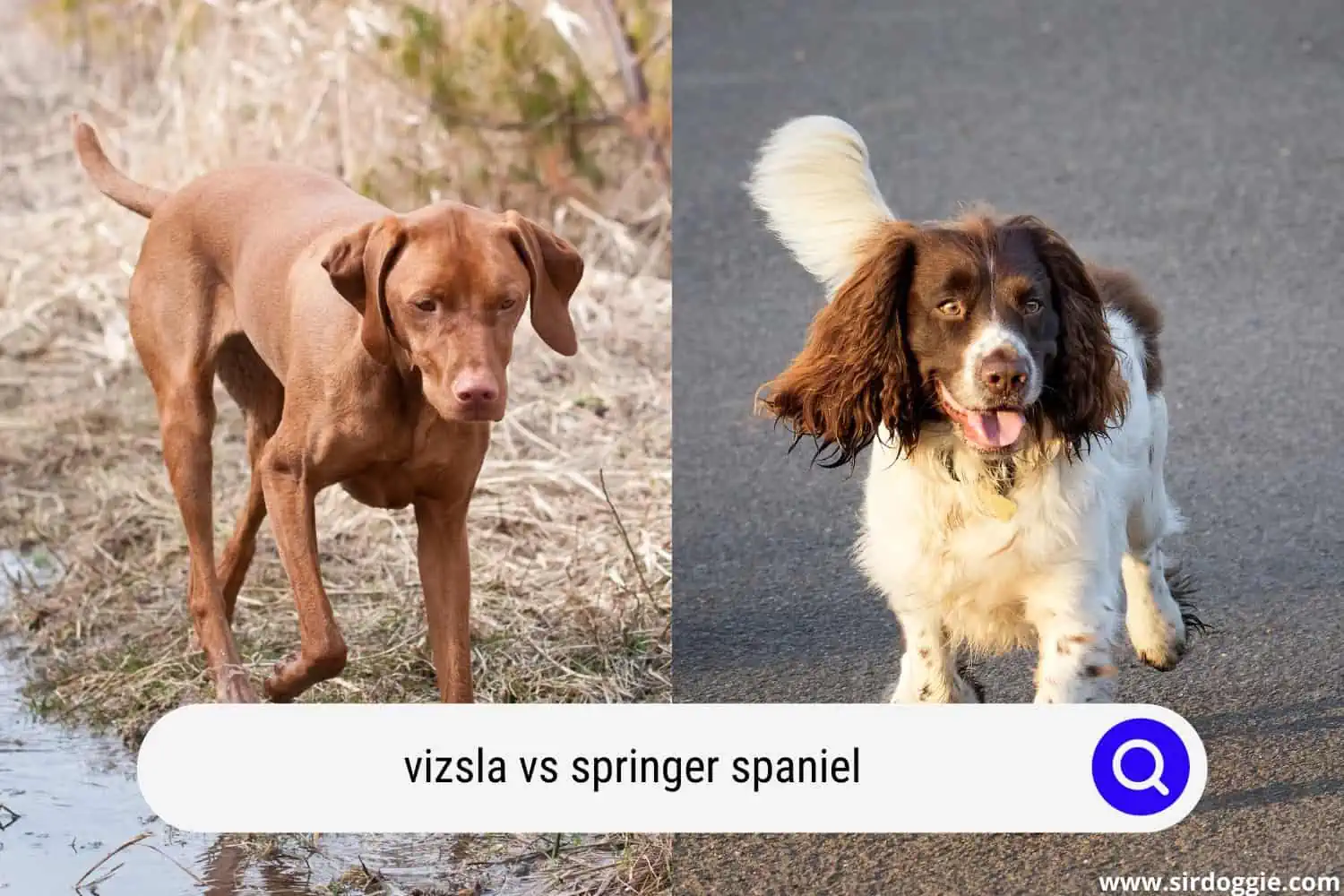Vizsla vs Springer Spaniel: What’s the Difference?
The Vizsla and the Springer Spaniel don’t look completely similar in appearance but they have similar temperament, and care requirements, and are adorable. Both are highly playful breeds and are loyal, gentle, soft, and affectionate towards other pets and handlers.

But still, a few indices set these two lovely creatures apart. In this Vizsla vs Springer Spaniel comparative article, we will analyze the origin, characteristics, character, care, and training needs, as well as their common pathological issues (if any) of both breeds.
The Vizsla
The Vizsla also called the Hungarian Bracco, Hungarian Hound, or Magyar Vizsla is a very sweet dog to get to know better. Its name, Vizsla, is usually read to mean “alert,” or “Velcro dog,” due to its strong attachment to its master. Today it is mostly present in Hungary, England, Germany, and the United States.
This a skilled hunting dog that is loyal to its master and docile like few others. There are two varieties, the short-haired (more common) and the wire-haired one. Here is our guide to getting to know the breed better.
Origin of the Vizsla
It is very difficult to trace the origins of this breed. It is hypothesized that they arrived in Hungary in the 9th century, together with the Magyar tribes, who migrated from the steppes of Asia. Among these populations, the Vizsla was used as a hunting dog.
It had already gained popularity during the 18th century when it became the faithful companion of the noble aristocrats during hunting trips. Then during the two world wars, it experienced a period of darkness, nearly entering extinction.
Its ancestors include the Pannonian Hound, the German Hound, the Arabian Greyhound, and the Turkish Yellow Dog. The goal of the various selections was to obtain a breed that could hunt in the most diverse environmental conditions. This is the aspect that best characterizes the Vizsla today.
Vizsla characteristics
The Vizsla stands out for its sweet look and appeal. It is a medium-sized dog that is tall at the withers, between 58 and 64 cm. The weight tends to fluctuate around 30kg. The body is muscular but well-tapered, with an elegant gait.
The legs are webbed, so it is also a skilled swimmer. The hair is golden wheat-colored, as are the oval-shaped eyes and the nose. Different shades and gradations are available, but the overall color usually remains uniform all over the body. There may also be tiny white spots on the throat, chest, or fingers.
The tail is long and narrow. The muzzle is long and pointed. The head appears rather broad, with the skin well adherent. The lips are tight, the jaws strong and muscular, with the ears hanging.
Vizsla character
The Vizsla is a pointing dog that is always attentive, available for work, and always alert. It can hunt in different contexts, from woods to plains and even in water. The sense of smell is highly developed, as are his abilities as a retriever.
It stands out for the sweetness and affection it shows above all towards its master. Some believe that this attachment is downright morbid, constantly needing physical contact.
Its predisposition to interaction makes it one of the dogs suitable for pet therapy. Not surprisingly, it is also a great playmate for the little ones.
It allows itself to be trained very easily, showing a unique dedication to its pack leader while still a puppy. This dog has not lost its hunting nature. It needs to move, to find its prey, to be in contact with nature. When all this is deprived of it, the dog begins to become impatient.
This breed hardly ever barks while keeping with its quiet and sociable disposition. However, it does so only when needed.
Vizsla Health, diet, and care
The good rules to follow when feeding this dog breed are relatively simple and there are no particular prescriptions. The Vizsla needs a healthy, regular, and balanced diet, possibly with the best quality food possible. The dog needs well-balanced meals of at least 400-500 grams a day. The sheen of its coat will thank you.
Generally, this dog has a fairly long average life expectancy. Among the most common pathologies are polymyositis, hip dysplasia, and visual diseases.
Related Reading: Vizsla vs Basenji: What’s the Difference?
Springer Spaniel
The origins of the Springer Spaniel are very ancient. It is considered one of the most experienced search and retrieval dogs and is a skilled swimmer. Let’s find out everything about this canine breed.
Origin of the Springer Spaniel
The natural inclination of the Springer Spaniel is evident already in the meaning of its name: “spring.” This is a term that alludes to its particular ability to ‘jump’ the game without stopping it. We are talking about a dog breed selected in England for hunting.
The recognition of the English Kennel Club dates back only to 1902 when it was under the name of English Springers. Despite the continuous evolution of the breed, the Springer Spaniel is considered by experts to be the oldest British hunting dog.
Springer Spaniel characteristics
The Springer Spaniel looks like a compact looking dog that is strong and well-proportioned. Being the progenitor of the Spaniels, it has the most developed and harmonious limbs. The height at the withers averages 51 cm per 20 kg of weight.
Like all hunting dogs, the Springer Spaniel is also very active, lively, and alert. The dog is a born runner, hyperactive in open spaces, but extremely balanced and calm in the home.
These behavioral characteristics are also reflected in its appearance: sweet almond-shaped eyes and dark hazel. Its hanging ears, and well-developed and toned muscles in movement express strength and agility.
The legs are powerful and muscular and the forward and ‘gliding’ gait is a distinctive feature of this dog breed. During walks, the tail wags briskly and is usually drawn downwards.
The coat is white and brown or black and white. The coat is smooth, very thick, slightly wavy, and has some pretty fringes on the ears and limbs which make it even more elegant.
There is a type of Springer of American origin that is considered the show version of the Springer Spaniel. In size, it is a bit smaller, the ears longer and the ‘saddled’ coat, much longer and full of fringes.
Springer Spaniel character
Perhaps not everyone knows that the Springer Spaniel is considered the brother of the Cocker Spaniel with whom it shares different character attitudes. It is always well disposed to human contact and with other dog breeds. The dog is cheerful, sweet, and is not wary of strangers. It is not a biting dog and it is very difficult for it to assume aggressive attitudes.
When well-trained, it turns out to be smart and a good listener. It is a versatile dog, which expresses its best when it can run around in spaces rich in vegetation. As mentioned, the Springer Spaniel is a lively, orderly, and polite dog and can be cuddly with the members of its family. With a few tricks, it will become a perfect companion dog.
Springer Spaniel diet, training, and care
Given the premises on the character of the Springer Spaniel, it is clear that this canine breed does not need iron fist training. Also suitable for a few experienced owners, it will prove to be a faithful and loving companion. It’s never intrusive at home and is inclined to play with children.
It is an extremely active and rustic dog, quite long-lived and not subject to particular pathologies. Anyone who decides to take care of a Springer Spaniel will need to pay close attention to their diet. It is a dog that is prone to gaining weight. Therefore, it needs to eat 250 grams of meat a day, along with boiled rice and vegetables.
Comparison table: Vizsla vs. Springer Spaniel
| Characteristics | Springer Spaniel | Purebred Vizsla |
| Breed Type | Purebred | Purebred |
| Price | $700-$800 | $800-$1200 |
| Size | Medium | Large |
| Weight | Male: 45 to 55 pounds, Female: 40 to 50 pounds | Male Vizsla: 45-60 pounds, Female Vizsla: 40-55 pounds |
| Coat | Feathered | Fine, Short, Dense, Hard and Coarse Coat with No Undercoat |
| Grooming | Advanced. It requires a lot of grooming. | For First-Time Owners? |
| Shedding Level | Sheds moderately. | Shed moderately. |
| Trainability | Easy to train. | Easy to train. |
| Barking | Barks occasionally. | Barks occasionally. |
| Biting Potential | Low | Low |
| Apartment Friendly | Very apartment-friendly. | Not recommended for an apartment. |
| Stranger Friendly | Very stranger friendly. | Average friendly towards strangers. |
| Child Friendly | Kid-friendly. | Kid-friendly. |
| Cat Friendly | average friendly to cats. | average friendly to cats. |
| Dog Friendly | very dog-friendly. | average friendly |
| Detection of Sniffer Dog? | No | No |
| Detection or Sniffer Dog? | Yes | Not really |
| Search and Rescue (SAR) dog? | Yes | Not really |
| Life Expectancy | 10-14 years | 10-14 years |

Conclusion
Both the Springer Spaniel and the Vizsla are high-energy dogs that require a lot of exercise. The two breeds are friendly to humans, cats, dogs, strangers, and other pets. They both have a life expectancy of 10 to 14 years. They don’t bite and they seldom bark. While both are easy to train, they shed hair moderately.
However, while the Springer Spaniel requires advanced hair grooming, the Vizsla has moderate grooming needs. Although both are purebreds, the Springer Spaniel can be found for a price of around $700-$800 while the Vizsla can be found for a price range of $800-$1200.

Family Dog Expert Author
Hi there! I’m Stuart, a devoted dog lover and family dog expert with over a decade of experience working with our furry companions. My passion for dogs drives me to share my knowledge and expertise, helping families build strong, loving bonds with their four-legged friends. When I’m not writing for SirDoggie, you’ll find me hiking, playing with my beautiful dog, or studying music.